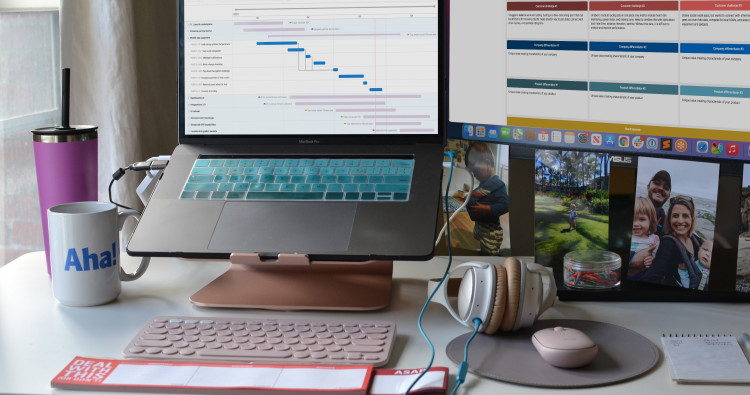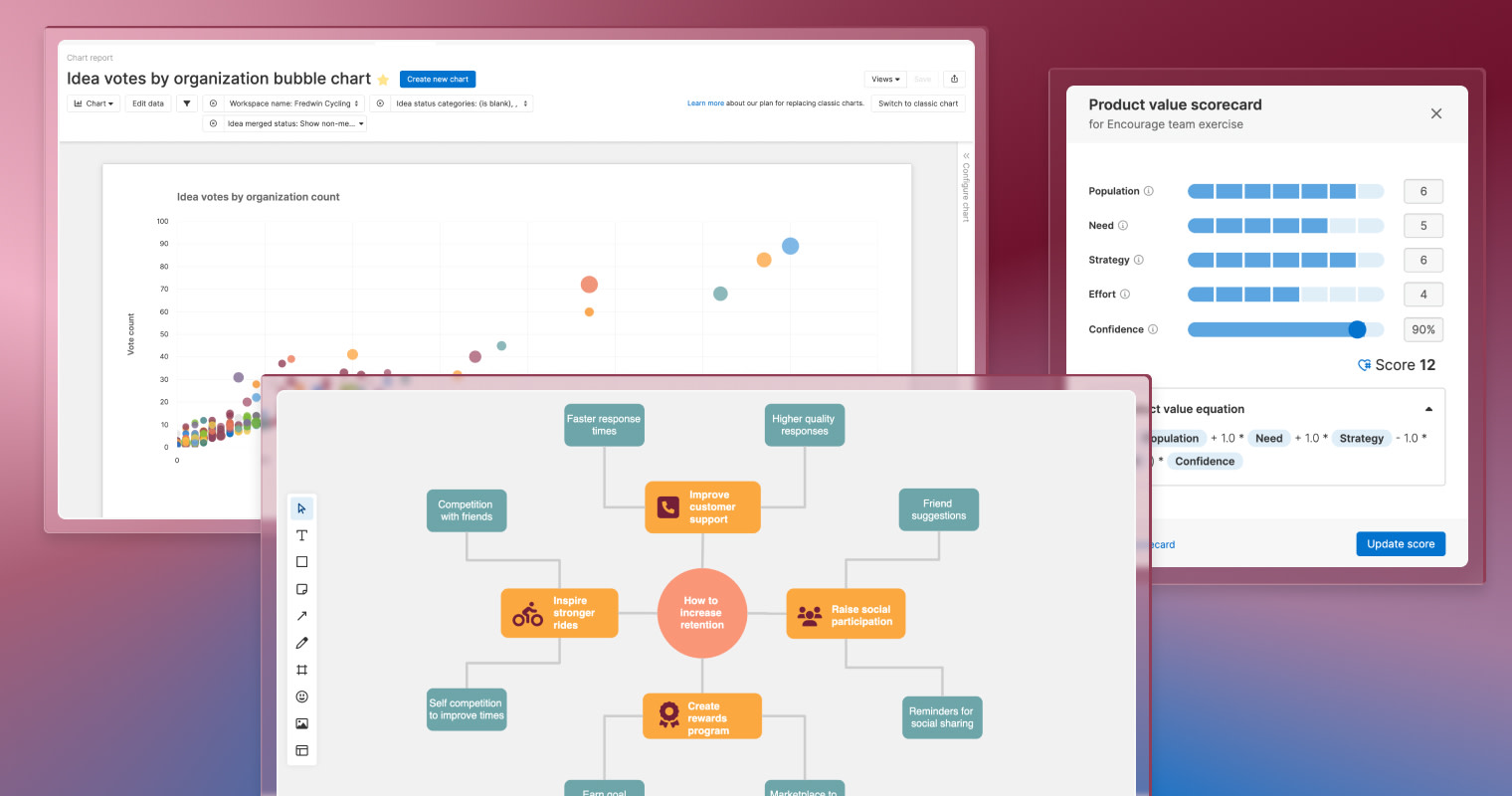
A snapshot of what launched in Q2 in Aha! software.
The Most Popular Aha! Software Features From Q2 2022
Aha! Notebooks (referenced here as Aha! Create) has been split into Aha! Knowledge and Aha! Whiteboards.
Product development is a team sport. It requires everyone to bring their best each day — working together to deliver exceptional customer and business outcomes. The tools you use to bring your products to life — from strategizing and ideating to planning, building, and launching — are fundamental to your success. This is why we are committed to giving product teams the functionality needed to do your jobs well, collaborate effectively, and add real value for customers.
Over the last few months we launched major enhancements to our suite of products — bringing you new ways to streamline your workflows and create real value at every step in the product development lifecycle.
The introduction of the new product value scorecard marked a big step forward in how product teams can measure the value of work. Now you can use the same set of metrics (i.e., population, need, strategy, effort, and confidence) to score new ideas and prioritize features for release. There has been steady interest from customers asking how to use the scorecard and take a value-based approach to product work — be sure to join us on July 20 for a live tutorial.
A few weeks ago, we launched virtual whiteboards across Aha! Ideas, Aha! Roadmaps, and Aha! Develop. You can now create individual and team whiteboards to sketch and plan early-stage concepts — right alongside the rest of your product work. We are thrilled by the early feedback we have received. As one customer aptly put it: "The ability to convert whiteboard elements into work items is the icing on the cake." Look out for improvements to this exciting functionality over the coming months as we prepare to make whiteboards available in Aha! Create as a standalone product with digital notes later this summer.
We also delivered some important updates to each of our individual products. From feedback polls in Aha! Ideas to custom workspace templates in Aha! Roadmaps and improved agile reports in Aha! Develop — we continue to invest in ways to streamline every step in the product development process.
Let's take a look back at top functionality launched in Q2 2022:
New in Aha! Ideas
We delivered a number of advanced idea management features to help you better understand what your customers want:
Poll your customers
Bring quantitative data into your decision-making. The ability to launch feedback polls in your ideas portal makes it super easy to ask questions and request input. Include multiple pre-defined answers and track the percentage of people that selected each one. Use the learnings to deliver experiences that delight your customers.
Create a dedicated polls page on your ideas portal in addition to sharing roadmaps and announcements with your community with custom portal pages.
Sync customer data in Salesforce
Many of you store rich details about your customers in Salesforce. So it makes sense that you would want to bring that information into Aha! Ideas and add context to the feedback. That is why we enhanced our Salesforce integration to make it possible to sync account and opportunity data with organizations. This helps you better understand the importance of new ideas — to both customers and the business.
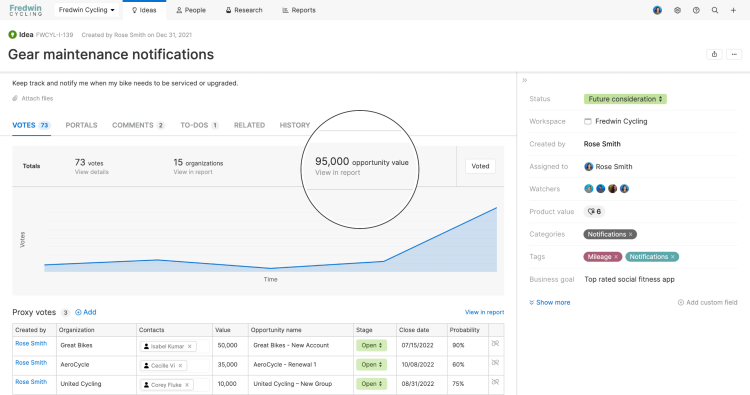
View the total opportunity amount and the individual proxy votes that comprise it from the votes tab of an idea.
Analyze the value of ideas
We also added three new example reports to help you understand how many organizations and customer segments want each idea. Visualize ideas based on total vote and organization count in a bubble chart, review your most popular ideas with a list report, or compare top ideas by segment in a pivot table.

Adjust any example report to view the exact data you need by adding fields and filters, such as idea status.
New in Aha! Roadmaps
In Q2, we focused on key ways to improve team collaboration and roadmap planning:
Organize around value
Let's take a closer look at the new product value scorecard. You can start by estimating the value of new ideas as they come into your ideas portal. Then, refine the score as you do more research. The scoring mechanism is consistent across ideas and features, so you can better decide which ideas to promote and then prioritize features for release. Customers on the Enterprise+ plan can use automation rules to keep scorecard metrics up-to-date based on the value of other fields.

Easily change the weighting of the product value categories by updating the coefficients in the default formula.
Visualize your thinking
Need to map out a bold new concept? Create a whiteboard in your personal notes to capture early thoughts. Then move it to a workspace note when you are ready to collaborate with the team. You can also embed a whiteboard within the description field of an Aha! record (with the exception of idea records) to visualize how new functionality should work.
Intuitive drawing functionality — including shapes, sticky notes, and diagrams — help you bring raw concepts to life. Note that whiteboards are available in Aha! Ideas, Aha! Roadmaps, and Aha! Develop.
Streamline roadmap planning
We continue to invest in ways to help large organizations manage complex processes. The introduction of custom workspace templates helps you standardize across teams, while a recent update to capacity planning for teams lets you detail the effort needed for individual team members to deliver work. These enhancements are available for customers on the Enterprise+ plan.

Team members automatically update when you link to an Aha! Develop team.
New in Aha! Develop
Engineering teams deserve an agile dev tool that puts team happiness and productivity first. Here are even more ways to tailor Aha! Develop to fit the way you work:
Improve your productivity
Tune out the noise and stay focused on what needs to get done. Collapse and expand columns on your workflow board to simplify your view. We also created extensions to drive personal and team productivity. Smoothly navigate the workflow board using a mini-map, assign yourself reminders with a single click, and set a timer to track how long it takes to complete tasks.

Click on the chevron for any collapsed column to expand it again.
Integrate your tech stack
We continued to expand our extensions library this quarter. Now you can connect Aha! Develop with Azure Pipelines and GitHub Actions for visibility into the status of your code — from pull request to deployment. We also built new extensions to make it easier to import technical issues that are captured in an Aha! ideas portal or in Salesforce Service Cloud.
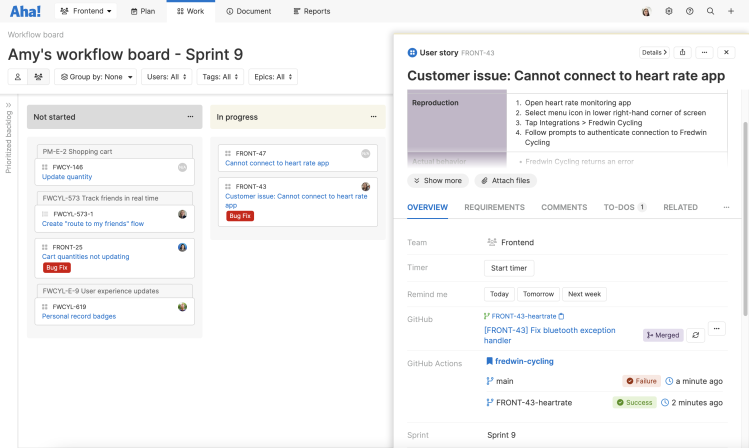
See every branch that includes the Aha! reference number and the status of the most recent build.
Analyze team performance
"How long will it take?" We launched a new cycle and lead time report to help you predict completion dates and improve workflows. We also made it possible to drill into agile reports — including burndown, velocity, and throughput — to gain deeper insights into team performance.
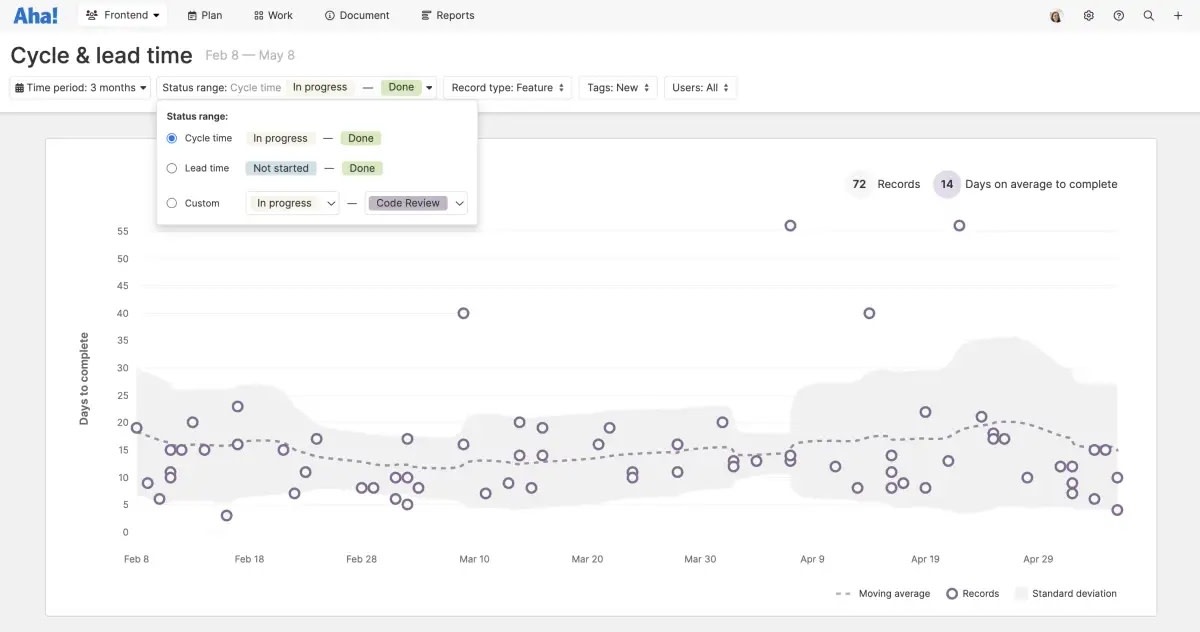
Click on any dot on the cycle and lead time report to get more details on the work item.
Our goal is provide best-in-class functionality for each step in the product development process — so you can achieve your product vision and goals.
Of course, we believe that the real magic happens when you connect each of those steps in a seamlessly integrated product development environment. The benefits that come from improved collaboration and visibility is how product teams can go from good to great.
Start a free trial today — be happy
If you are not already an Aha! customer, you may want to sign up for a free 30-day trial of Aha! Ideas, Aha! Roadmaps, or Aha! Develop. You can also join a live demo to see why more than 500,000 users trust our software to build lovable products.
Aha! is a trademark of Aha! Labs Inc. All other company and product names may be trademarks of the respective companies with which they are associated.


